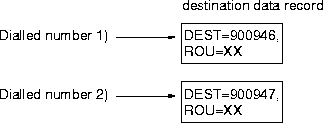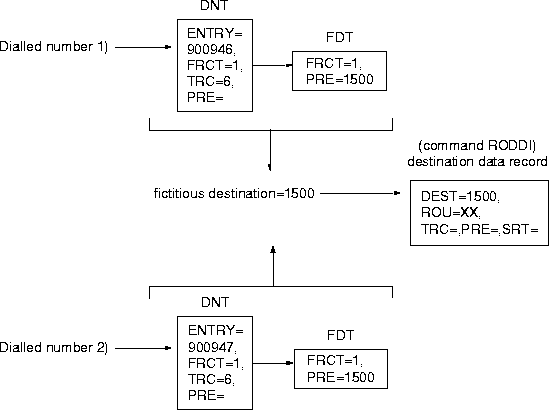DNT - Destination Number Table
The DNTs are where the main least cost routing takes place. Instead of letting the dialed number address a destination data record (command RODDI) directly into a fictitious destination that address a destination data record the dialed number is modified in the DNT and FDT.
Different dialed numbers that are to be routed the same way, are transformed into the same fictitious destination. Several entries in each of the DNTs are possible, but since many of them will be transformed into the same fictitious destination they will address the same destination data records. This means that LCR will only use some of the 2500 destination data records available (that has to be shared with basic routing and PNR). This is how LCR increases the capacity of external analysis.
Dialed number 1 is 9-009-46-8-90510 Dialed number 2 is 9-009-47-31-244061


The savings are perhaps even more obvious if one consider that there may be alternative choices for each destination. For example, if five different numbers (that are to be routed the same way) are initiated with five routing choices each, not using LCR, will require 25 destination data records, while only five destination data records are sufficient if LCR is used.
As can be seen in the figure above there is the possibility to prefix both in the DNT and the FDT. The prefix in the DNT may be used for transit network selection. One example in the US is AT&T that have 288, in Sweden Tele2 have 007. see the example 2 below.
Furthermore there is the possibility to prefix in the destination data record. This is when the number needs to be transformed differently for different route choices. By using a truncation (parameter TRC), prefixing (parameter PRE), and start digit sending (parameter SRT), the number may be modified in all possible ways.
First the PRE in the DNT is applied, then the PRE in the FDT, and lastly the PRE in the destination data record.
The DNT1 and the DNT2
A destination number may be analyzed in either of two levels of depth. The DNT1 table analysis 16 digits depth which is good for analyzing exception numbers (since ENTRY then must comprise the whole number). The DNT2 table analysis 8 digits depth and is used for number series.
- First the dialled number is modified according to the assigned TRC and PRE data (LCDDI:TAB=DNTx,ENTRY=,TRC=,PRE=).
- Second, an entry in the DNT tables must have a Fictitious Route Choice Table (FRCT) initiated. The FRCT is not a table but an index to the Fictitious Destination Table (initiated with LCDDI:TAB=FDT) where a prefix is found.
The prefix in the FDT is used for prefixing the previously modified number.
- The result is a fictitious destination to be analyzed, that is, since it is an external destination it will address a destination data record (a DEST initiated with RODDI).
Example 1, Basic LCR
The number series in this example is 9 009 46 8, where the digit 9 is the least cost routing access code (LAC), 009 is the international prefix, 46 is the country code to Sweden, and 8 is the trunk code for Stockholm. This number should be initiated in the number table, DNT2, with the appropriate data for addressing a fictitious destination.
Start with creating a fictitious destination to be used for outgoing calls to Stockholm. (In this example the destination used is 0120.) Initiate the FDT that should prefix the dialed number (that previously was modified in a DNT) so that it addresses the above fictitious destination:
LCDDI:TAB=FDT,PRE=0120,FRCT=22; Any entry in a DNT that refers to FRCT=22 will be prefixed with 0120.
Initiate the number series with appropriate data regarding the above:
LCDDI:TAB=DNT2,ENTRY=9009468,TRC=1,FRCT=22; The leading digit 9, in the number 9 009 46 8 is truncated. The modified number will be 009 46 8.
After that, the FRCT=22 indexes the FDT where the prefix 0120 is found. The result is that the dialed number 9 009 46 8 is transformed into 0120 009 46 8, where the digits 0120 is the fictitious destination used to address a destination data record (initiated with RODDI:DEST=0120,..).
The same FRCT may be used by other modified numbers. The result is that calls to different external destinations are now calls to the same fictitious destination.
Example 2, Basic LCR with Transit Network Selection
If different transit networks are wanted for different numbers that are to use the same FRCT, the PRE in the FDT is used. For example, if AT&T transit network is wanted for calls to Stockholm, Sweden, the number should be prefixed with 288 in the DNT.
LCDDI:TAB=DNT2,ENTRY=9009468,TRC=1,PRE=288,FRCT=22; The leading digit 9, in the number 9 009 46 8 is truncated, and after that the number is prefixed with 288. With the prefix 0120 in the FDT the result will be the number 0120 288 009 46 8.
Example 3, Exception Number Using PDC
An exception is a number within a series, that is barred from calling. The barring is controlled in the toll restriction on a per category basis. With Forced account code which is set per extension, the barring may be further refined (parameter ROC in command EXTEI), and this is also valid for generic extensions.
Exceptions may be initiated using LAC or PDC. In this example PDC is used. The PDC make use of the LCR tables, but only Toll restriction (and Forced account code) is used. No least cost routing will take place.
Initiate the number series as in the examples above, but using the PDC=01 instead of the LAC=9.
LCDDI:TAB=DNT2,ENTRY=01009468,FRCT=X;
The number in this number series that should be barred from calling is the number to the speaking clock. This number is 90510 in Sweden. The complete number 01 009 46 8 90510 is put in the exceptions table (DNT1) and is thereby barred or open for users, as stated in the parameter TOLL (toll restriction).
Toll restriction is a bit map table containing whether a TCD category is allowed or barred from calling a number stated in the DNT1 or DNT2. The toll restriction is set in the parameter TOLL in the DNTs, each bit in TOLL refers to a corresponding TCD category (0-14).
If the parameter TOLL is omitted all categories are allowed to call the stated destination, that is, all bits in the TOLL bit map are by default set to 1.
LCDDI:TAB=DNT1,ENTRY=0100946890510,FRCT=X,TOLL=000000000000000; Users of all TCD categories are barred from calling the speaking clock in Stockholm, Sweden.
Unlike in Example 1, basic LCR the dialed number will not be transformed according to the data in the DNT and FDT. In this example a PDC is used, and the dialed number is sent for external analysis.
Example 4, Time of Day
If the Time of day function is to be used, the parameter TZONE should also be set when initiating the FDT table. By using time of day, different fictitious destinations may be addressed depending on the time zone.
LCDDI:TAB=FDT,FRCT=22,PRE=0120,TZONE=1;
LCDDI:TAB=FDT,FRCT=22,PRE=0123,TZONE=4;
If a call is made during the time period represented by time zone 1 the number will be prefixed with 0120. Likewise, a call during time zone 4 will be prefixed with 0123.
The time zones are initiated with the LCTDI command. Further information on the LCTDI command can be found in the command description for LEAST COST ROUTING, LC
Example 5, Dialed Number Retrieval
Dialed number retrieval can be utilized if it is required that two or several different public numbers should address the same destination data record.
Dialed number retrieval is indicated by the value 3 in D16 in the ADC parameter in the RODDI command.
RODDI:DEST=..., ADC=...............3...;
When the value 3 is detected in the ADC D16 parameter the external number to use is composed by the destination code assigned for the route choice, together with the public part of the dialed external number.